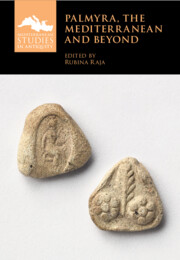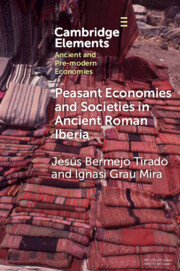Refine search
Actions for selected content:
6455 results in Classical Archaeology
4 The archaeology of Byzantine Thrace: The state of research (2015–2025) and future directions
-
- Journal:
- Archaeological Reports / Volume 71 / November 2025
- Published online by Cambridge University Press:
- 23 December 2025, pp. 87-104
- Print publication:
- November 2025
-
- Article
-
- You have access
- Open access
- HTML
- Export citation

The Archaeology of the Cyclades in the Roman and Late Antique Periods
- Globalization, Christianization and Resilience
-
- Published online:
- 23 October 2025
- Print publication:
- 06 November 2025

Palmyra, the Mediterranean and Beyond
-
- Published online:
- 21 October 2025
- Print publication:
- 16 October 2025
10 - Palmyrene Military Expatriation and Its Religious Transfer at Roman Dura-Europos, Dacia and Numidia
-
-
- Book:
- Palmyra, the Mediterranean and Beyond
- Published online:
- 21 October 2025
- Print publication:
- 16 October 2025, pp 212-231
-
- Chapter
- Export citation
3 - You Can’t Get There from Here
-
-
- Book:
- Palmyra, the Mediterranean and Beyond
- Published online:
- 21 October 2025
- Print publication:
- 16 October 2025, pp 33-48
-
- Chapter
- Export citation
Maps and Tables
-
- Book:
- Palmyra, the Mediterranean and Beyond
- Published online:
- 21 October 2025
- Print publication:
- 16 October 2025, pp x-x
-
- Chapter
- Export citation
7 - Language, Law and Religion
-
-
- Book:
- Palmyra, the Mediterranean and Beyond
- Published online:
- 21 October 2025
- Print publication:
- 16 October 2025, pp 141-166
-
- Chapter
- Export citation
2 - The Western Networks of Palmyra
-
-
- Book:
- Palmyra, the Mediterranean and Beyond
- Published online:
- 21 October 2025
- Print publication:
- 16 October 2025, pp 21-32
-
- Chapter
- Export citation
1 - Palmyra in the Mediterranean World
-
-
- Book:
- Palmyra, the Mediterranean and Beyond
- Published online:
- 21 October 2025
- Print publication:
- 16 October 2025, pp 1-20
-
- Chapter
-
- You have access
- HTML
- Export citation
8 - Channels of Communication and Connections of Style
-
-
- Book:
- Palmyra, the Mediterranean and Beyond
- Published online:
- 21 October 2025
- Print publication:
- 16 October 2025, pp 167-186
-
- Chapter
- Export citation
Copyright page
-
- Book:
- Palmyra, the Mediterranean and Beyond
- Published online:
- 21 October 2025
- Print publication:
- 16 October 2025, pp iv-iv
-
- Chapter
- Export citation
Contributors
-
- Book:
- Palmyra, the Mediterranean and Beyond
- Published online:
- 21 October 2025
- Print publication:
- 16 October 2025, pp xi-xiv
-
- Chapter
- Export citation
Figures
-
- Book:
- Palmyra, the Mediterranean and Beyond
- Published online:
- 21 October 2025
- Print publication:
- 16 October 2025, pp vii-ix
-
- Chapter
- Export citation
Index
-
- Book:
- Palmyra, the Mediterranean and Beyond
- Published online:
- 21 October 2025
- Print publication:
- 16 October 2025, pp 232-238
-
- Chapter
- Export citation
4 - Palmyrene Iconographic Traditions and Their Mediterranean Connections
-
-
- Book:
- Palmyra, the Mediterranean and Beyond
- Published online:
- 21 October 2025
- Print publication:
- 16 October 2025, pp 49-109
-
- Chapter
- Export citation
6 - Organizing Networks to Supply Mediterranean Markets
-
-
- Book:
- Palmyra, the Mediterranean and Beyond
- Published online:
- 21 October 2025
- Print publication:
- 16 October 2025, pp 127-140
-
- Chapter
- Export citation
Contents
-
- Book:
- Palmyra, the Mediterranean and Beyond
- Published online:
- 21 October 2025
- Print publication:
- 16 October 2025, pp v-vi
-
- Chapter
- Export citation
9 - Identity and Mobility of Palmyrene Jews
-
-
- Book:
- Palmyra, the Mediterranean and Beyond
- Published online:
- 21 October 2025
- Print publication:
- 16 October 2025, pp 187-211
-
- Chapter
- Export citation
5 - Palmyra and Emesa or ‘Palmyre sans Émèse’
-
-
- Book:
- Palmyra, the Mediterranean and Beyond
- Published online:
- 21 October 2025
- Print publication:
- 16 October 2025, pp 110-126
-
- Chapter
- Export citation

Peasant Economies and Societies in Ancient Roman Iberia
-
- Published online:
- 19 September 2025
- Print publication:
- 09 October 2025
-
- Element
- Export citation
